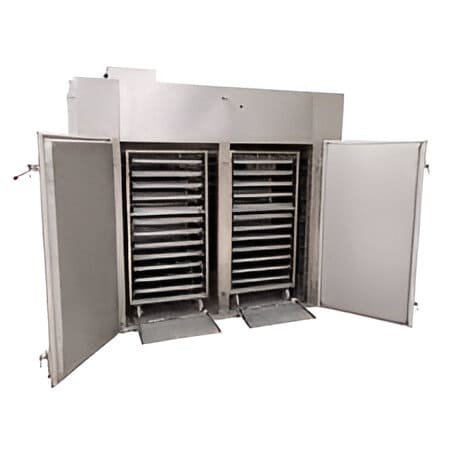Numerous industries, including the food processing, pharmaceutical, paper, pollution control, and agricultural sectors, use tray dryers. Paper for printing and packing operations, edible materials for further processing into well-known delicacies and snacks, and chemicals for research and medicinal purposes are just a few of the diverse materials that require drying in entirely different industries.
Through evaporation or sublimation, dryers are used to extract liquids or moisture from bulk solids, powders, components, continuous sheets, and other liquids. Direct and indirect dryers are the two primary categories. Direct dryers use heated air, gas, or a product made of combusted gas to convectively heat a product. Indirect dryers use contact with a heated wall to conductively heat a product.

The Tray Dryer is used to dry wet materials such as chemicals, grains, powders, and crude medications. The most basic type of drying is a laboratory oven, which is a cabinet with a heater at the bottom.
Because the humidity and heat transfer cannot be controlled, these ovens are of very little use assuming the oven has a fan installed. The forced hot air circulated in that situation, increasing heat transfer and decreasing local valor concentrations. There is insufficient control in spite of this. The directed circulation form is the best kind of tray dryer or tray drying machine. The heated air is distributed throughout the material by the regulated flowing system.
The material is spread on the tiers of the trays to dry quickly. The trays used have solid, perforated, or wire mesh bottoms. The screen tras are lined with paper to circulate across rather than through the drying materials. The paper is used as a disposable tray liner to reduce cleaning time and prevent contamination.
With carefully positioned fans and heating coils, a modern tray dryer’s well-insulated cabinet maintains a consistent temperature and air quality. The shelves are arranged differently to allow air to circulate freely and completely. Before going through each frame, the reheated air is provided by the fitted heater design.
There is a certain amount of heat that contributes to the latent heat for vaporization as the air passes over each shelf. Such dryers can have reasonable humidity and heat control thanks to proper design.
A Tray Dryer is a type of traditional drying apparatus that consists of trays stacked on top of one another in a trolley and enclosed, insulated chambers. The driers are employed in processes where heating and drying are essential components of the industrial manufacturing process, such as in the production of food items, pharmaceuticals, dyes, and chemicals, among other things. The materials that need to be dried are either wet or solid and are put on trays.
A steam in an electric heater or radiator coil circulates hot air to transfer the heat through the trays. Additionally, the equipment has a control panel for temperature control and other parameters fixed outside the equipment that aid in its operation. The installed blower fans facilitate the transfer of heat and the proper circulation of heat.
The basic working principle of this machine is continuous circulation of hot air in the tray dryer moisture is removed from the solids that are placed in the trays by a forced conventional heating the moist air is removed is conducted partially but in a simultaneous fashion.
Initially the wet solids are loaded into the trays and the trays placed in the dryer chamber. There is then the introduction of fresh air through the inlet. the air passes through the heaters where it is heated up. the objective of the heating is to ensure that heated air reaches the wet solids on the tray therefore the fan in the tray dryer are used to circular the hot air at a speed of 2 to 5 metre per second. The turbulent flow reduces atmospheric partial vapour pressure and thickness of the layers of air boundary.
During water evaporation, which is the diffusion of water from the solids’ interior through a capillary action, the heated air absorbs water from the surface. Every event listed above takes place in a single airborne pass. A maximum of 20 percent of fresh air is introduced, and the discharge air is circulated back through the fans at a rate of 80 to 90 per cent due to the brief contact time and the small amount of water picked in a single pass.
In order to maintain a consistent temperature over the solid material and achieve uniform drying, the moisture discharge happens through the outlet. when wet granules, like those found in capsules or tablets, need to be dried. The drying process is carried out repeatedly until the desired moisturizer content is reached. After being removed from the chamber, the drying trucks or trays are transported to the trade dumping station.
Overall, the tray dryer’s spacious working area, robust design, regulated temperature, even air circulation, and fundamental functioning principle. It includes, among other things, any equipment that has the remarkable and exquisite capacity to aid in the drying of plastic and chemical powder, electrodes, bakeries, and food.
Accumax India is a leading Tray Dryer manufacturer in India and all over the world.The company has its own manufacturing unit.Buy Tray Dryer at a fair price with excellent warranty terms.


